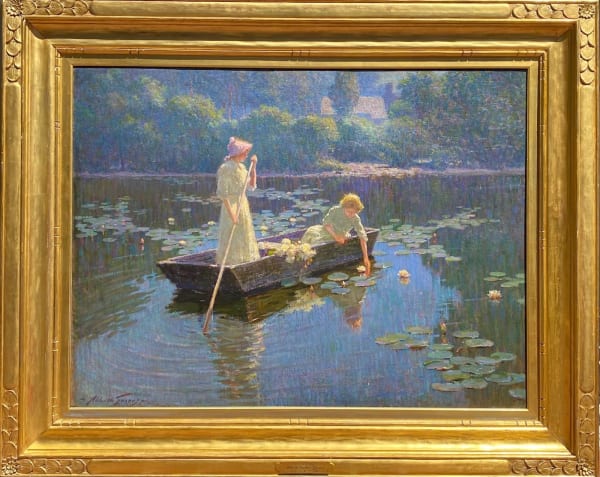Kenneth Noland
Kenneth Noland was an American painter who used minimal compositions to explore form and color.
Early Life and Education
Kenneth Noland was born in Asheville, North Carolina in 1924. He had four brothers. Noland’s father was a pathologist, who painted in his spare time, and let Noland experiment with his paints and brushes. Noland attributes his interest in art to his father’s influence and to an exhibition of Monet’s paintings that he saw at the National Gallery in Washington, D.C. when he was fourteen.
After graduating from high school in 1942, Noland enlisted in the U.S. Air Force. After serving in the military for four years, he returned to the U.S. and, through the G.I. Bill, enrolled in the experimental Black Mountain College, which was close to his family home, and where two of his brothers also studied art.
At Black Mountain, Noland was introduced to color theory by Bauhaus artist Josef Albers. Noland became interested in the works of Piet Mondrian and Paul Klee.
After spending two years at Black Mountain, Noland traveled to Paris in 1948 to study with the Russian sculptor Ossip Zadkine. In 1949 he had his first one-man show at the Galerie Raymond Creuze in Paris.
Career and Personal Life
Noland returned to the United States after a year in Paris and began his teaching career. He taught at the Institute of Contemporary Art in Washington, D.C. from 1949 to 1951, then at Catholic University in D.C. from 1951 to 1960, and at the Washington Workshop Center for the Arts from 1952 to 1956.
It was in D.C. that Noland met fellow artist Morris Louis.Both Noland and Louis were painting in the style of the Abstract Expressionists of the time. The two friends were invited by art critic Clement Greenberg to visit the New York studio of Color Field artist, Helen Frankenthaler. Seeing Frankenthaler’s poured paint on unprimed canvas had a profound effect on Noland.
He returned to his D.C. studio and began to paint simple circles with minimal colors on raw canvas. He also experimented with shaped canvas, but retuned to minimalist style with circles and chevrons.
Noland’s work was widely exhibited throughout his life. He had his first New York solo exhibition at the Tibor de Nagy Gallery in 1957. In 1964, his works were shown at the American pavilion at the Venice Biennale. Other solo exhibits of Noland’s work were held at such notable venues as the Tate, Museo de Bellas Artes de Bilbao and the Guggenheim.
Noland was married four times and had four children. He died in 2010, at the age of 85, at his home in Port Clyde, Maine. where he continued to paint until the final days of his life.
Kenneth Noland’s work is part of the permanent collection of the Guggenheim, the Whitney, MoMA, the Met, the National Gallery in D.C., the Tate, London, the Centre Georges Pompidou in Paris, the Stedelijk Museum in Amsterdam, the Kunstmuseum in Basel, Switzerland and other museums and galleries around the world.
Send me more information on Kenneth Noland
-

Surovek Gallery at Art Miami 2023
November 30, 2023At Surovek Gallery our focus is on the finest American paintings, drawings, watercolors and prints of the 19th, 20th and 21st centuries; the oeuvre which...Read more -

Recent Acquisitions at Surovek Gallery
Works by Abbott Fuller Graves, Thomas Hart Benton, Milton Avery, Sam Francis, Orville Bulman, Kenneth Noland and Mel Bochner September 29, 2023We are pleased to announce our recent acquisitions of works by some of America’s finest artists, representing a wide range of styles and techniques. The...Read more


